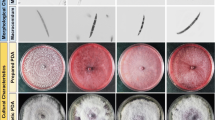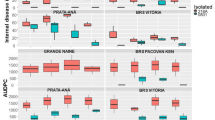Abstract
The soil-borne fungus Fusarium oxysporum can cause both Fusarium yellows and Fusarium root rot diseases with severe yield losses in cultivated sugar beet. These two diseases cause similar foliar symptoms but different root response and have been proposed to be caused by two distinct F. oxysporum formae speciales. Fusarium yellows, caused by F. oxysporum f. sp. betae, presents vascular discoloration, whereas Fusarium root rot, due to F. oxysporum f. sp. radicis-betae, appears as black rot visible on the root surface. The aim of this work was to study the host-pathogen interaction between sugar beet lines and isolates originally characterized as Fusarium oxysporum f. sp. betae. Eight susceptible sugar beet lines, selected by the USDA-ARS (US) and UNIPD (University of Padova, Italy) breeding programs, were inoculated with three different isolates of F. oxysporum f. sp. betae, the causal agent of Fusarium yellows, representing different genetic groups. All inoculated lines developed symptoms, but severity, expressed as area under the disease progress curve (AUDPC), differed significantly (P < 0.05) among lines. Two lines from UNIPD, 6 and 9, were the most susceptible to the disease, whereas the other lines showed similar levels. The three isolates of F. oxysporum f. sp. betae differed significantly (P < 0.05) in disease severity. Five weeks after inoculation the plants were harvested and roots examined. Surprisingly, severe root rot was observed in the susceptible UNIPD lines when inoculated with all three isolates, while this symptom was never observed in the USDA germplasm. The development of this disease symptom obviously depends on the plant genotype.

Similar content being viewed by others
References
Armstrong, G. M., & Armstrong, J. K. (1981). Formae speciales and races of Fusarium oxysporum causing wilt diseases. In In Fusarium: Diseases, Biology and Taxonomy (pp. 391–399). University Park: Penn State University Press.
Coe, G. E., & Hogaboam, G. J. (1971). Registration of sugarbeet parental line SP 6322-0. Crop Science, 11, 947.
Halloin, J. M., Saunders, J. W., Theurer, J. C., & McGrath, J. M. (2000). Registration of EL51 sugarbeet germplasm. Crop Science, 40, 586.
Hanson, L. E., Hill, A. L., Jacobsen, B. J., & Panella, L. (2009). Response of sugarbeet lines to isolates of Fusarium oxysporum f. sp. betae from the United States. Journal of Sugar Beet Research, 46, 11–26.
Hanson, L. E., & Hill, A. L. (2004). Fusarium species causing Fusarium yellows of sugarbeet. Journal of Sugar Beet Research, 41, 163–178.
Hanson, L. E., & Jacobsen, B. J. (2009). Fusarium yellows. In R. M. Harveson, L. E. Hanson, & G. L. Hein (Eds.), Compendium of Beet Diseases and Pests (pp. 28–29). St. Paul: APS Press.
Harveson, R. M., & Rush, C. M. (1997). Genetic variation among Fusarium oxysporum isolates from sugar beet as determined by vegetative compatibility. Plant Disease, 81, 85–88.
Harveson, R. M., & Rush, C. M. (1998). Characterization of Fusarium root rot isolates from sugar beet by growth and virulence at different temperatures and irrigation regimes. Plant Disease, 82, 1039–1042.
Harveson, R. M. (2009). Fusarium root rot. In R. M. Harveson, L. E. Hanson, & G. L. Hein (Eds.), Compendium of Beet Diseases and Pests (pp. 30–31). St. Paul: APS Press.
Hill, A. L., Reeves, P. A., Larson, R. L., Fenwick, A. L., Hanson, L. E., & Panella, L. (2011). Genetic variability among isolates of Fusarium oxysporum from sugar beet. Plant Pathology, 60, 496–505.
Kroes, G. M. L. W., Baayen, R. P., & Lange, W. (1998). Histology of root rot of flax seedlings (Linum usitatissimum) infected by Fusarium oxysporum f. sp. lini. European Journal of Plant Pathology, 104, 725–736.
Lewellen, R. T. (2004). Registration of rhizomania resistant, monogerm populations C869 and C869CMS sugarbeet. Crop Science, 44, 357–358.
Martyn, R. D., Rush, C. M., Biles, C. L., & Baker, E. H. (1989). Etiology of a root rot disease of sugar beet in Texas. Plant Disease, 73, 879–884.
McGrath, J. M., Derrico, C. A., Morales, M., Copeland, L. O., & Christenson, D. R. (2000). Germination of sugar beet Beta vulgaris L. seed submerged in hydrogen peroxide and water as a means to discriminate cultivar and seed lot vigor. Seed Science and Technology, 28, 607–620.
Olivain, C., & Alabouvette, C. (1999). Process of tomato root colonization by a pathogenic strain of Fusarium oxysporum f. sp. lycopersici in comparison with a non-pathogenic strain. New Phytologist, 141, 497–510.
Panella, L., Ruppel, E. G., & Hecker, R. J. (1995). Registration of four multigerm sugarbeet germplasm resistant to Rhizoctonia root rot: FC716, FC717, FC718, and FC719. Crop Science, 35, 291–292.
Rowe, R. C. (1980). Comparative pathogenicity and host ranges of Fusarium oxysporum isolates causing crown and root rot of greenhouse and field-grown tomatoes in North America and Japan. Phytopathology, 70, 1143–1148.
Author information
Authors and Affiliations
Corresponding author
Ethics declarations
Conflict of interest
The authors declare that they have no conflict of interest.
Human and animal rights
This research does not include any animal and/or human trials.
Ethical approval
The authors bear all the ethical responsibilities of this manuscript.
Rights and permissions
About this article
Cite this article
Hanson, L., De Lucchi, C., Stevanato, P. et al. Root rot symptoms in sugar beet lines caused by Fusarium oxysporum f. sp. betae . Eur J Plant Pathol 150, 589–593 (2018). https://doi.org/10.1007/s10658-017-1302-x
Accepted:
Published:
Issue Date:
DOI: https://doi.org/10.1007/s10658-017-1302-x




